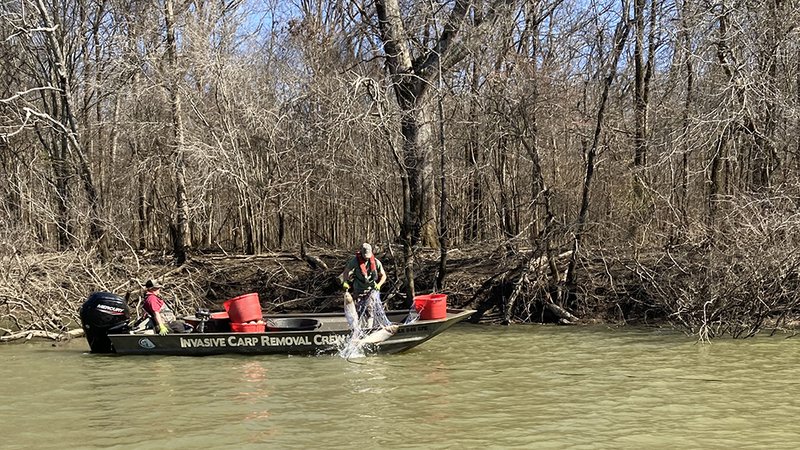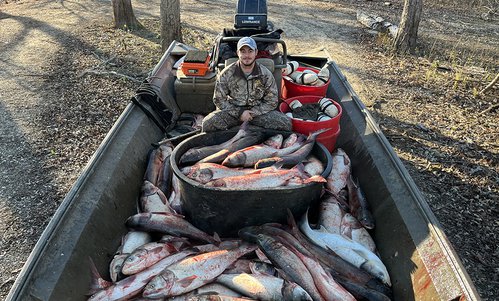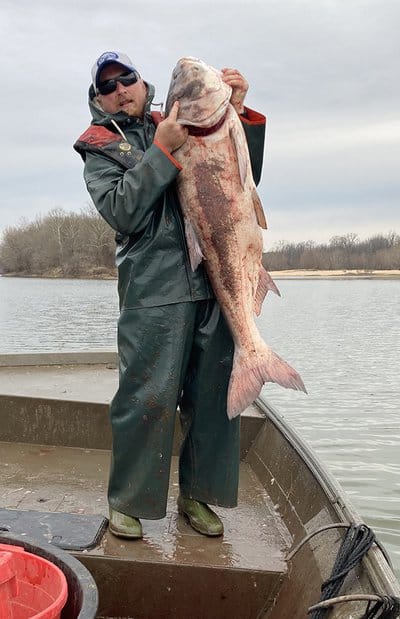Arkansas invasive carp team getting foothold despite fickle river conditions
ON 07-06-2022

July 6, 2022
Randy Zellers
Assistant Chief of Communications
HAZEN — Swollen rivers in central and east Arkansas may have slowed the Arkansas Game and Fish Commission’s new carp control team from reaching their potential so far this year, but they haven’t stopped their drive. Since October, two AGFC netting crews have been on the water every day conditions would allow, and have pulled nearly 41,000 pounds of invasive carp from the White and Arkansas rivers.
“On good days, we may pull as much as 1,500 pounds of invasive carp from the river, but we can only work when conditions are right,” Jimmy Barnett, invasive carp biologist for the AGFC said.
The invasive carp crews started working on the White River last October, but river conditions forced them to move their focus to the Arkansas River in February.
“Typically each crew runs about 800 yards of nets per day, so we stay busy for each 10-hour day we’re out there,” Barnett said.
Instead of letting a net soak for a day or two, the AGFC’s carp team runs active sets. They are constantly checking the nets to minimize any mortality in species other than invasive carp.
“We’re targeting silver, bighead, black and grass carp,” Barnett said. “But the nets will occasionally catch some large gar, buffalo and other non-target species. We don’t want to remove or kill those fish, so they get released as soon as we find them.”
The invasive carp species, however, are kept onboard the boat and disposed of at the end of the day.
“We’ve been able to give some to some permitted alligator snapping turtle farms to make use of the meat, and I’m hoping to set up something with the Little Rock Zoo or other location that can use the meat,” Barnett said. “Right now, Arkansas does not have a commercial processing facility that will take carp, but we’re hopeful someone will see the opportunity to establish one.”
The new effort by the AGFC was made possible by funding from the U.S. Fish and Wildlife Service. Four grants totaling $1.2 million were received by the AGFC, including a portion directly attributed to removal of invasive carp species.
Barnett said until recently there wasn’t any federal funding available for invasive carp removal in the Lower Mississippi River Basin. Instead, federal dollars were focused on preventing the spread of the species in the northern portions of the Mississippi River and its tributaries.
“It’s a great way to get your foot in the door with the agency and be a part of conservation,” Barnett said. “We’ve had two of our employees move on to full-time jobs in other divisions of the agency since we started less than a year ago. It’s also one of the highest-paid extra labor jobs we have at the agency.”
The two positions Barnett mentions are still open at the AGFC’s job-recruiting page, https://jobs.agfc.com, and he’s excited to give some new conservationists a way to join the effort.
“We’re always looking for additional hands,” Barnett said. “Someone who can run a boat and has some previous experience running nets would definitely find the job rewarding, but we’ll train you if you’re willing to work. We have a long way to go to meet our goals, but we’re getting better every day.”
Recent News
Subscribe to Our Weekly Newsletter E-mails
Don’t miss another issue. Sign up now to receive the AGFC Wildlife Weekly Newsletter in your mailbox every Wednesday afternoon (Waterfowl Reports are published weekly during waterfowl season and periodically outside the season). Fishing Reports arrive on Thursdays. Fill in the following fields and hit submit. Thanks, and welcome!


